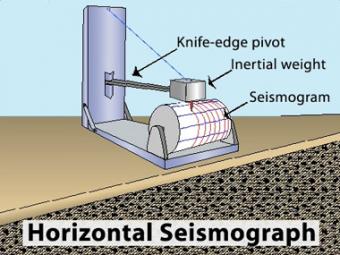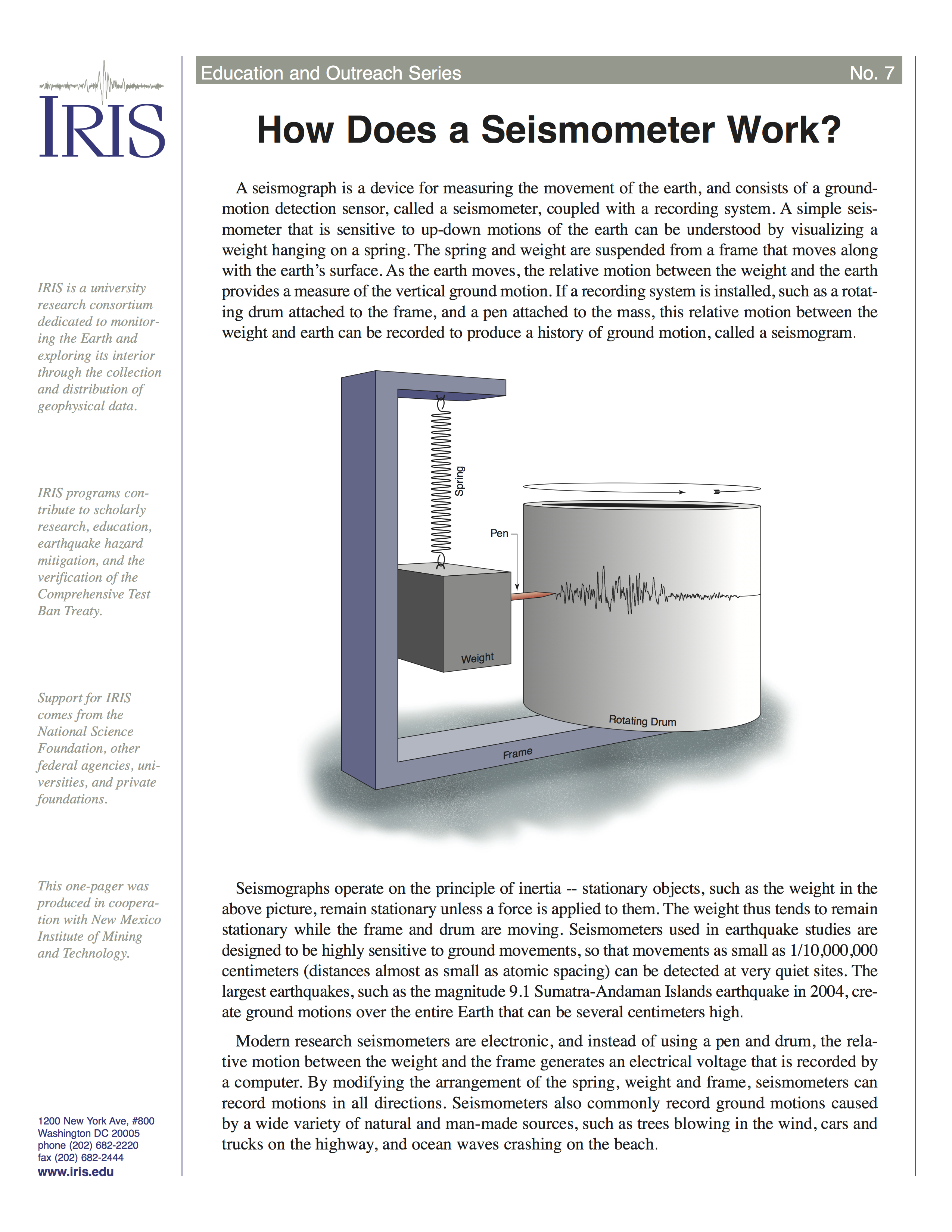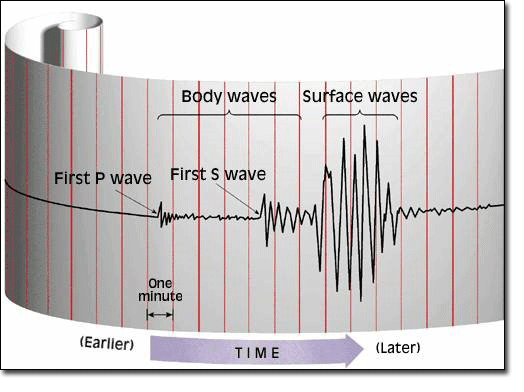Describe the Principle of a Seismograph
Surface wave are waves that travel into the rock layers below the surface. After reading studying and discussing the chapter students should be able to.
Body waves are composed of two principal types.

. The seismographs are said to be equipped with the electromagnetic sensors that generally translate the ground motions into charges which are electrical. They are usually combined with a timing device and a recording device to form a seismograph. 6 What is a tsunami.
Intermediate speed and amplitude Surface waves. If you live in a city you may have noticed that buildings sometimes shake when a big truck or a subway train rolls by. By way of triangulation.
That ratio is called the velocity or acceleration sensitivity of the seismograph. A seismograph works by anchoring a recording drum to the bedrock below it. When there is NO EARTHQUAKE reading there is just a straight line except for small wiggles caused by.
An earthquake causes loose saturated sandy material to liquefy shoot upward. 82 Compare and contrast the types of seismic waves and describe the principle of the seismograph. Measuring spots are set up in three or more regions.
The idea behind a seismograph is fairly simple. Movements of the magnet relative to the case generate small electric signals in the wire which can be sent to a computer or recorded onto paper to create a seismogram. Seismograph works on the principle of inertia to measure the depth and force of earthquake.
81 Sketch and describe the mechanism that generates most earthquakes. Primary waves p waves are compress waves that travel through solids and liquids. In what two ways do earthquakes generate tsunami.
On a seismogram the HORIZONTAL axis time measured in seconds and the VERTICAL axis ground displacement usually measured in millimeters. 83 Distinguish between intensity scales and magnitude scales. Secondary waves s waves are shear waves and they travel through only solid materials.
5 List four factors that affect the amount of destruction caused by seismic vibrations. As seismic waves move the ground the drum records the amount of displacement occurring using the suspended stationary weight as a reference point. Fundamentally a seismograph is a simple pendulum.
The basic principle in the construction of a seismograph is that it must consist of a sufficiently heavy weight suspended in such a manner that the weight will not move when the earth over which the seismograph rests vibrates due to an earthquake. What is the underlying principle of seismograph construction. Seismometer The basic PrinciplesSeismometer The basic Principles u g x x 0 x r using the notation introduced the equation of motion for the mass is m k h m D r r r g x t x t x t u t 2 0 0 2 0 2 2 ε ϖ ϖ ε ϖ From this we learn that.
Seismographs operate on the principle of inertiaThe underlying principle of seismograph construction is to have a heavy weight suspended from a spring over a base or within a moving. The output of such a deviceformerly recorded on paper or film now recorded and processed digitallyis a seismogram. A seismograph is a device for measuring the movement of the earth and consists of a ground-motion detection sensor called a seismometer coupled with a recording system.
Measures waves using inertia. 8 Contrast the physical makeup of the asthenosphere and lithosphere. It is equally possible to take the ratio between the deflection of the pendulum and the velocity or acceleration of the ground.
A pen hangs from the weight and a rotating drum. Seismograph instrument that makes a record of seismic waves caused by an earthquake explosion or other Earth-shaking phenomenon. A seismograph is the device that scientists use to measure earthquakes.
The seismograph can record and measure the waves of earthquakes. 4 Describe the principle of a seismograph. - for slow movements the acceleration and velocity becomes negligible the.
The data collected from each seismograph it compared and contrasted to locate the epicenter and focus. The goal of a seismograph is to accurately record the motion of the ground during a quake. The term seismograph is an instrument that generally makes a record of waves which is seismic and is caused by an explosion of the earthquake or other Earth-shaking phenomenon.
The horizontal seismograph shown here moves only in the horizontal plane. Up to 24 cash back Learning Objectives. Fastestleast amplitude S waves.
A basic seismograph includes a solid base and a heavy weight suspended from a spring over the base. Seismographs operate on the principle of inertia. Explain how seismographs are used to locate the epicenter of an earthquake.
A seismograph is a device for measuring the movement of the earth and consists of a ground- motion detection sensor called a seismometer coupled with a recording system. Slowest speed most amplitude P waves can pass through liquid whereas S waves cannot. Describe how sand volcanoes form.
As the distance between the epicenter of an earthquake and a seismograph station increases so does the difference in the arrival times of the P and S waves. The P primary wave comparable to sound waves which compresses and dilates the. In general then the seismograph is an instrument in which the relative motion of pendulum and ground is recorded.
Surface waves that move side-to-side are the most destructive to buildings. 7 What evidence do we have that Earths outer core is molten. Such data is used to.
Seismographs are equipped with electromagnetic sensors that translate ground motions into electrical changes which are processed and recorded by the instruments analog or digital circuits. As it moves it records the pendulum displacements as they change with time tracing out a record called a seismogram. A seismometer is an instrument that responds to ground noises and shaking such as caused by earthquakes volcanic eruptions and explosions.
S wave - P wave Surface Wave Compression wave. Ground shakes the base and frame of the instrument move with it but intertia keeps the pendulum bob in place. Vertical seismographs like the simple one shown here use a soft link between the earth-anchored instrument and the suspended mass.
The sudden force of earthquake makes the scale pointer to move and after the tremor the pointer comes back to its initial position due to its inertia of rest. Describe the principle of the seismograph. It will then appear to move relative to the shaking ground.

How Does A Seismometer Work Incorporated Research Institutions For Seismology

How Does A Seismometer Work Incorporated Research Institutions For Seismology


No comments for "Describe the Principle of a Seismograph"
Post a Comment